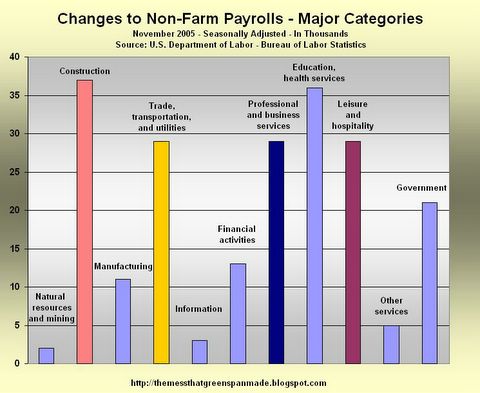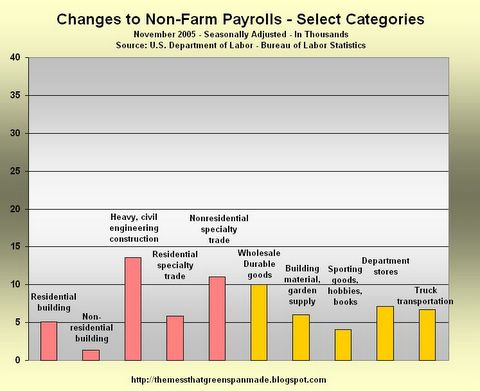More Restaurant Jobs
Monday, December 05, 2005
On Friday, the Labor Department reported that 215,000 non-farm payroll jobs were added during the month of November. This news, along with higher than expected third quarter GDP growth and rising consumer confidence announced earlier in the week, was heralded as further evidence that the U.S. economy is recovering nicely from the devastating hurricanes and rising energy costs from a few months ago.
Treasury Secretary Snow put it thusly (and had a nice chart as well):Today's report ends a week of very good news for the American economy. Wednesday's revised estimate of third quarter GDP growth for 2005 came in at a robust 4.3 percent. Consumer confidence is rebounding, industrial production is up, early reports are that holiday sales are strong, and new home sales just hit a record high. These are the unmistakable hallmarks of a strong economy and are encouraging news for America's families. A steady stream of positive indicators has given us increased confidence that the underlying fundamentals of our economy are solid, and that our path of growth is steady.
Well, that's one view.
Let's have a look at the data ourselves before jumping to conclusions about the underlying fundamentals. Let's take a look at the type of jobs that were created last month - to better see how solid things really are. One can learn so much more by looking beyond the headline statistics, past the mainstream financial media reporting - especially for something as important as job creation.
The first chart shows the seasonally adjusted monthly change for all employment categories from the Bureau of Labor Statistics. If you add up all the bars, you get the headline number of 215,000.
Click to enlarge
Once again Construction is right up there near the top, followed closely by the unstoppable Education and health services category (education and health services has been the most steady job creation category for the decade so far - nothing seems to slow it down, however, it is just not that important in assessing the fundamentals of the economy).
Only slightly behind the two leaders are the familiar Trade, transportation and utilities, Professional and business services, and Leisure and hospitality categories. These five categories accounted for about 160,000 new jobs last month - over 80 percent of all private sector non-farm payroll jobs created (remember, it takes roughly 150,000 new jobs per month to keep pace with the rising population.)
Four of these five categories are expanded below by selecting the best performing sub-categories within each major category. As not all sub-categories are included, some of which had job losses, the components will not add up to the totals indicated in the chart above.
Breaking down construction and trade, two things become clear; nonresidential construction is making a comeback and consumer spending is still going strong.
Click to enlarge
In months and years past the residential construction categories have handily outpaced the civil engineering and nonresidential categories - it really hasn't even been close. The change last month is presumably due, at least in part, to the reconstruction work going on in the Gulf Coast, and after acknowledging that, you have to wonder who is ultimately paying the wages for all these new jobs.
Hint: $200,000,000,000 new government debt, Asian trading partners, etc.
The trade category once again shows that consumers keep spending, Home Depot and Lowe's keep hiring, and there will be even more tractor-trailers on the road hauling goods from West Coast ports to distribution centers around the country, ultimately destined for the shelves of your local low-price retailer.
All these charts are on the same scale, by the way - you'll see why in a few seconds.
Breaking down the professional services and leisure categories, the broad-based nature of the jobs report can be seen clearly - many categories within the professional services category show solid growth. Within the leisure category, things aren't so broad-based.
Click to enlarge
It is not known how many of the new professional services jobs are related to the reconstruction - not too long ago, there was a story going around about some company offering unfathomable wages for anyone who could navigate one of those project scheduling software packages and who was also willing to temporarily locate to the south.
As for the food services category, we continue to marvel at what we have become as a nation - yes, employers are still creating jobs, but what a different mix than in decades past. As seen in this previous post, throughout the first half of this decade, food service employment has been right up there with education and health care - unstoppable.
Everyone needs to be educated and everyone needs medical care when they get sick, but everyone doesn't need to eat out, do they? Doesn't anyone cook anymore?
Over 800,000 new food service jobs in the last five years, over 2.5 million in the last fifteen years - remarkably consistent at between 150,000 and 250,000 new jobs in this single category almost every year for the last fifteen years.
During the period 2001 thru 2003, when three million private sector jobs were lost, food service employment racked up gains of nearly 500,000, no doubt spurred on by the refinancing/home equity withdrawal wealth effect.
The big maroon food service bar in the chart above may actually be a little misleading. It may say more about how out of date the BLS's employment categories are than anything else. Consider that there are 31 categories for the 14+ million manufacturing that remain in this country, but only seven categories for the nearly 13 million jobs in leisure and hospitality.
The labor categories should probably be expanded to properly reflect the new role of the American wage-earner - no longer manufacturing as much, but rather, serving a new leisure class - homeowners.











![[Most Recent Quotes from www.kitco.com]](http://kitconet.com/charts/metals/gold/t24_au_en_usoz_2.gif)
![[Most Recent Quotes from www.kitco.com]](http://kitconet.com/charts/metals/silver/t24_ag_en_usoz_2.gif)
![[Most Recent USD from www.kitco.com]](http://www.weblinks247.com/indexes/idx24_usd_en_2.gif)

6 comments:
Here's an interesting question: How many shares of GM stoxk does it take to buy one hummer?
some good commentary and links on the broken window fallacy:
http://www.marginalrevolution.com/marginalrevolution/2005/09/the_broken_wind.html
Ah, the servant driven ecconomy, How will we able to afford foreign goods?.....Or will we only be able to afforg foreigns when we all work at bars and restaurants. (sound of Chinese man with evil laugh in back ground)
I also live in SoCal (Los Angeles)... The amount of people that I know who cook on a regular basis can be counted on one hand. Everybody else seems to eat out min. 3 times a week up to every meal. Most people that I know eat out almost every meal. I am always pleasantly surprised when I meat someone who still cooks.
A comparison of wage levels of these jobs would be interesting. It sounds like most job creation is in low to medium brackets and probably highest among illegals.
I eat out nearly every working day for lunch. Many people do that hereabouts, judging by how busy food places are. The reason I don't usually go to the company cafeteria is that it is of crappy and declining quality, and the company apparently doesn't bother to bring in a better vendor or light a fire under their butt. May say something about required levels of appreciation for employees. From a financial and certainly value-for-money perspective going out for lunch is a wash, even with the additional gasoline cost.
The people who bring their lunch, or go home for it, are generally Asian homeowners (including Indians).
Post a Comment